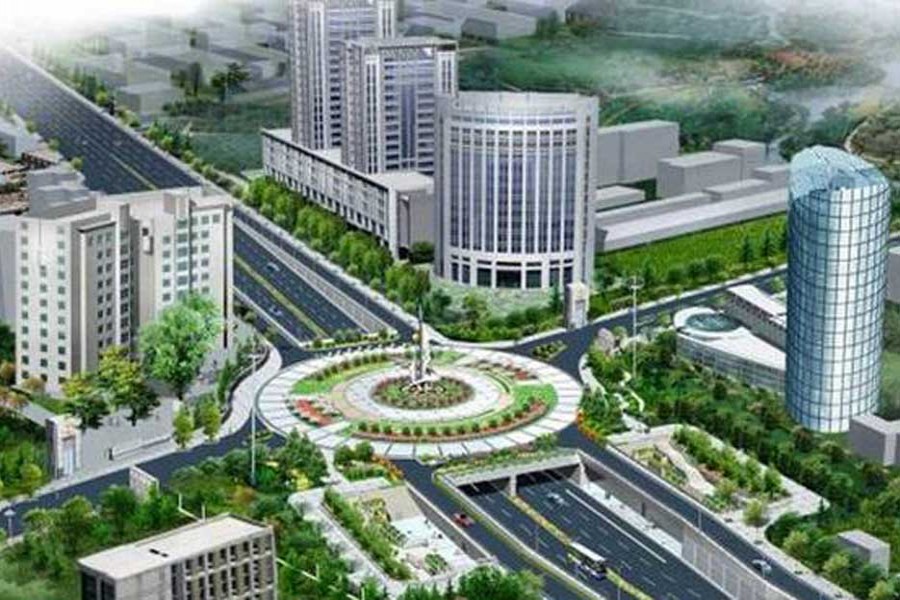Dhaka city is gradually becoming unliveable due to lack of proper planning and policies. In an unprecedented event, 2.0 million people moved into the city in the last five years resulting in unplanned and chaotic urbanisation.
Urban planning is undeniably facing a host of challenges in Bangladesh. Every year 100,000 people are being added to the existing population out of which 41 per cent of total urban population live in Dhaka.
In recent years, Bangladesh has experienced an annual urbanisation growth of 3.3 per cent with 540 million people living in the urban centres and the number is predicted to double in the next three decades. Urban areas contribute 60 per cent of the country's gross domestic product (GDP). Dhaka and Chittagong together share 47 per cent of the total output.
Bangladesh needs to address the critical challenges brought about by the massive unplanned urbanisation, characterised by high-level poverty, and generally poor housing conditions and liveability. More than one out of five urban dwellers in Bangladesh lives in poverty.
According to Bangladesh Bureau of Statistics (BBS), nearly 62 per cent of the urban population, which is about 30 million people, currently live in makeshift settlements and slums. The country's urban centres need a minimum of $2.0 billion annual investment for basic infrastructure, such as roads, water and sanitation, to meet the demand of the rapidly growing urban population.
Only three per cent of the total public expenditure is on urban infrastructure development in Bangladesh, which is very low by global standards. Bhutan spends 16 per cent, Nepal 10, Indonesia 34 and South Africa 52 per cent.
Bangladesh is experiencing an unbalanced regional urbanisation with its western cities and towns witnessing low or minus growth in contrast to those in the eastern part, including Dhaka city, says a United Nations study.
Urbanisation is obviously a development phenomenon, and it can have negative impacts on economy and environment for lack of proper planning. The filling up of lowlands in the capital and its peripheries is making it very difficult for the authorities to keep the city's environment clean and run the water supply and drainage systems properly.
According to a study, the population of Dhaka city rose by 46 per cent between 2001 and 2011, while that of other eastern cities and towns grew between 57 and 331 per cent. A key factor in slow urban growth in the western region is the poor socio-economic condition of the hinterland of its urban centres. The region also has poor transportation connectivity with the more dynamic eastern part of the country.
Dhaka city consists of only one per cent (1371 square km) of the country's land but it has more than 10 per cent of the total population. As such, the country's urbanisation is heavily focused on Dhaka city having a population of 16.2 million. The second largest urban centre -- Chittagong city -- has a population of 3.2 million.
Northern cities and towns, except for Bogra, have not seen establishment of that many industrial units and related urban facilities. Besides, construction of the Bangabandhu Bridge over the Jamuna resulted in large-scale migration to Dhaka from the north and north-western region.
Dhaka has become the ultimate urban centre for people from across the country, and some 40 per cent of GDP is generated from here. But the large-scale migration has created huge problems for the city's water and drainage systems and its environment.
Continued growth is hindered in the capital city when supplies of electricity and water are unreliable, and when the urban transport system is poorly managed, congested and chaotic. Part of the problem is weak city governance, as there are many organisations that lack coordination among them.
There is, however, a need for developing secondary towns, creating employment facilities and quality health and education facilities outside Dhaka, introducing commuter trains or other transport systems connecting Dhaka city to rural areas, and empowering local governments.
There is no denying that urbanisation is expanding job and manufacturing opportunities. But more work is needed to fully capture the enormous benefits of urbanisation. Needless to say, only a well-managed urbanisation could lead to sustainable economic growth, allowing productivity and innovations. Strong and sustainable governance is the key to planned urbanisation in the country.
Combination of leadership, planning and investment, and meaningful consultation is required for transforming Dhaka into a liveable city. The elected city mayors should be empowered to make urban governance stronger.
As the Sustainable Development Goals (SDGs) aims at the country's inclusive development, the city planners should take population growth into consideration and help authorities plan accordingly. Professional groups and experts should make a coordinated approach for addressing the complex urbanisation issue.

- Friday, 10 January 2025 |
- Today's FE |
- e-Paper |
- Beta Website

